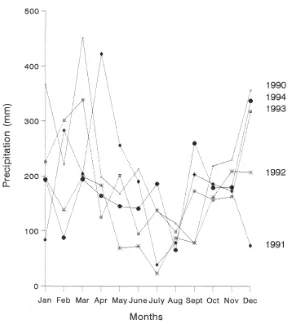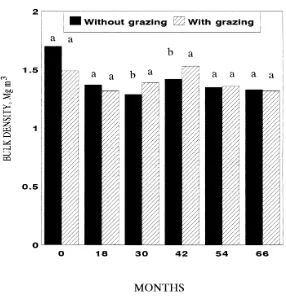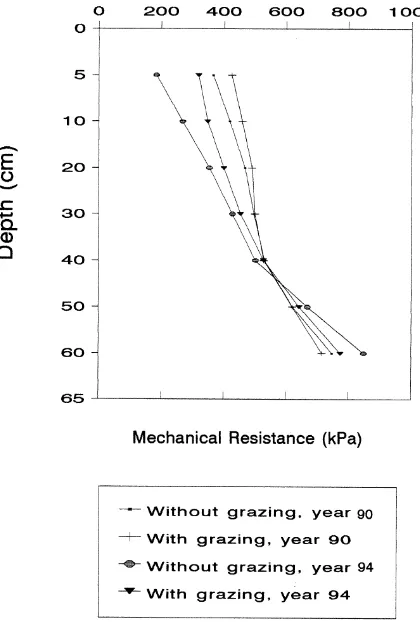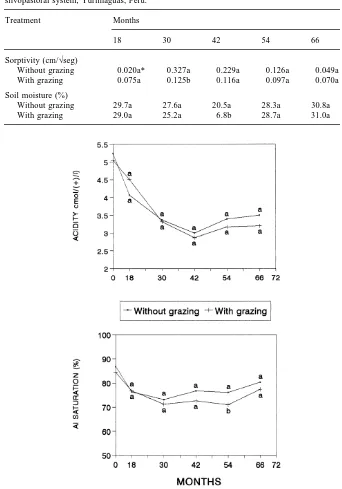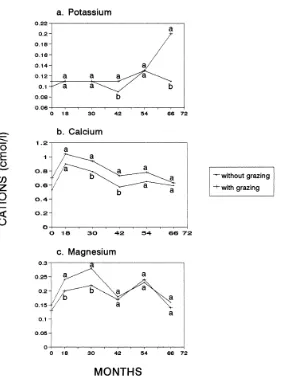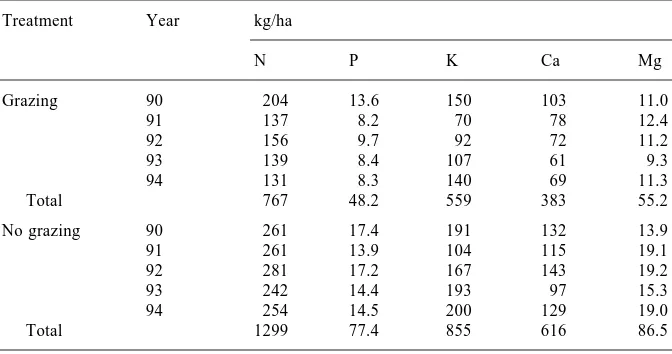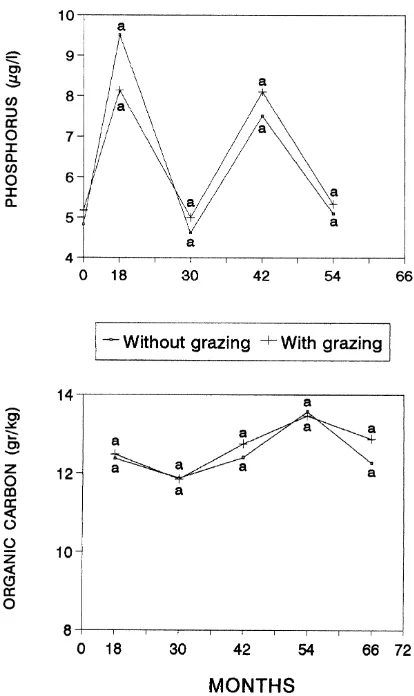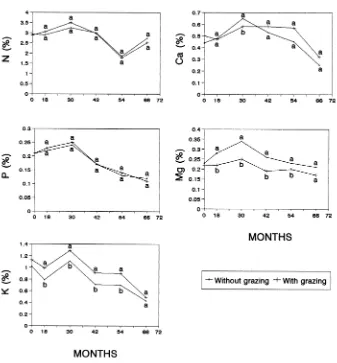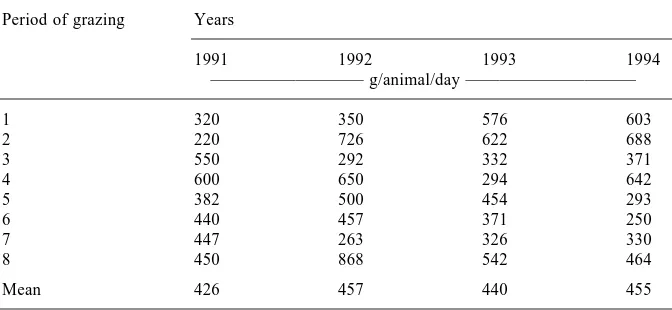The effect of cattle grazing on soil physical and
chemical properties in a silvopastoral system in the
Peruvian Amazon
L. A. AREVALO1, 2
, J. C. ALEGRE1, 2, *
, D. E. BANDY1
and L. T. SZOTT2
1 International Centre for Research in Agroforestry (ICRAF), P.O. Box 30677, Nairobi, Kenya; 2 Instituto de Investigación de la Amazonia Peruana (*Author for correspondence)
Key words: acid soils, cover crop, humid tropics, peach palm, Peru, silvopastoral system
Abstract. In a six-year-old peach palm (Bactris gasipaes) plantation, centrosema (Centrosema
macrocarpum), a leguminous forage plant, was established as a cover crop which was
eventu-ally grazed. This experiment was designed to monitor probable changes in soil physical and chemical properties and measure peach palm fruit production and live-weight gain of cattle grazing this silvopastoral system. The experiment was installed on land that was previously cleared by a D7 bulldozer having a straight blade that mixed the thin layer of topsoil with the acid subsoil (20–40 cm) and severely compacted the soil. The results demonstrated that the
centrosema cover crop reduced soil bulk density, increased water infiltration rates and reduced
mechanical resistance. In general soil physical properties were improved with the use of
Centrosema as forage and cover crop. Soil acidity and aluminum saturation decreased
consid-erably, while potassium concentrations increased. Calcium and magnesium concentrations decreased over time as these minerals were stored in the pasture biomass, translocated to fresh peach palm fruits and/or exported to animals. A strong competition for nutrients was observed between the peach palm plants and Centrosema. The low production of peach palm fruits was in response to mechanized land clearing during initial establishment of the plantation, and also probably due to deficits of N, P, K, Ca and Mg in the soil instead of being a consequence to the presence of cattle. The average increase in live-weight gains of the cattle was at a rate of 445 g/animal/day during the four-years of the study. Such an increase is substantially greater than those registered in the area under traditional grazing systems used in the region.
Introduction
In more than 80% of the Peruvian lower Amazon basin, cattle farming depends on native pasture ‘torourco’ which comprises basically a mixture of Axonopus
compressus S. W. Beauv and Paspalum virgatum L. The low productivity of
native grasses combined with the high stocking rate employed, results in rapid degradation of soil and thus of the physical, chemical and biological status of the pasture.
In order to improve these soil conditions and increase meat and milk pro-duction, silvopastoral systems, associating trees, pastures and animals can be a viable alternative. Incorporation of trees in the pasture lands gives the opportunity to increase land productivity by providing additional products such as fruits, wood and charcoal, in addition to forage for cattle.
Depending on the density of trees in silvopastoral systems, the selected
Agroforestry Systems 40: 109–124, 1998.
pasture species should have the following characteristics; grow at low light intensities, support trampling, withstand grazing pressure, and fix nitrogen. Previous experimental results have shown that centrosema (Centrosema
macrocarpum) in association with peach palm (Bactris gasipaes HBK)
plan-tations have great potential. This system is of great importance as it preserves the soil and supplies N to the peach palm plant (Perez et al., 1993). Moreover, the system minimizes hand labour for plantation maintenance.
Some leguminous forage plants used as cover crops tend to climb trees; therefore, they need to be frequently cut back. The manpower applied in this labour can be eliminated if the cover crop is grazed. However cattle grazing can increase soil compaction which in turn adversely affects tree growth, thereby diminishing total productivity of the system.
Among different leguminous forage plants evaluated for cover crops under different light intensities, Centrosema was the best (Perez et al., 1993), and in addition demonstrated greater tolerance to frequent grazing whether alone or in association with grasses in grazing systems without trees (Lara et al., 1991).
The role of the animal component the silvopastoral system of the Peruvian Amazon has not been adequately researched. Hence, an experiment was conducted in the peach palm/centrosema system with the objectives of (a) determining the effect of incorporating the animals on physical and chemical properties of soil, nutrient recycling and fruit production of beach palm, (b) regeneration of productivity of centrosema and (c) qualifying live-weight gain of cattle.
Materials and methods
Site description
The trial was started in October 1988, at the Experimental Station of San Ramón, near Yurimaguas, Peru. The Station is located at 5°56′south latitude, 76°5′ west longitude, at 184 m above sea level in a moist humid tropical ecosystem with a mean annual temperature of 26 °C and annual precipitation rate of 2,100 mm. Monthly rainfall exceeds 200 mm during nine months of the year but it is usually around 100 mm during July, August, and the monthly rainfall rate is over 200 mm except during July, August and September.
palm trees with a natural grass understorey. The area had a density of 1,200 peach palm plants/ha, three times greater than the optimum density (400 plants/ha). In May 1987, 50% of plants were eliminated in order to enhance fruit production. Before initiation of the silvopastoral trial, soil analysis results showed no residual effects of the applied nutrients (Table 1).
Establishment and management of cover crop
In October 1988, when peach palm was 6 years old, inoculated seed of centrosema was sown as an understorey cover with a spacing of 1 m between rows and 0.50 m between plants. About 20% of the area needed gap filling which was done a month after initial sowing.
Due to low content of nutrients in the soil (Table 1), 20 kg of P ha–1
as Bayovar rock phosphate and 20 kg K ha–1
as potassium chloride were spread over the entire area in May 1989. These are the recommended rates of fertil-izer for establishing new pastures, which would also be adequate for recouper-ation of degraded pastures (Ayarza, 1988).
The two main treatments for comparison were: (1) without grazing (trees and pastures); and (2) with grazing (trees, pastures and animals). The treat-ments were applied three times across a soil compaction gradient in the experimental area. The ‘no grazing’ plots were 600 m2
in all blocks, whereas the plots with grazing were 2,446, 2,253 and 1,509 m2
.
Eighteen months after the establishment of centrosema, grazing commenced with two young bulls of 180 and 171 kg each, at a stocking rate of 3.3 animals/ha. A rotational grazing system was used, with 9 to 14 days grazing periods and 28 to 30 days rest according to the size of the plots. Subsequently the stocking rate was reduced to 2.3 animals/ha because of the decreased availability of centrosema biomass during the dry season and to allow for recouperation of Centrosema. The cattle received an additional salt/mineral supplement.
Table 1. Chemical properties of the 0–20 cm soil layer at the start of the establishment of the
experiment in October, 1988, Yurimaguas, Peru.
Treatment Pa Acidityb Ca Mg Ka Al Sat
(µg/ml) —————— cmol/l —————— (%)
Without grazing 4.8 5.24 0.53 0.15 0.10 87 With grazing 5.2 5.07 0.71 0.13 0.11 84
Measurements
Biannual physical and chemical properties of the soil were monitored: at the end of the rainy season (April) and end of the dry season (October). Each plot was sampled according to a pre-determined sampling grid in order to draw samples from the same location over time. Nine samples were collected from the no grazing treatment, but 17 samples were collected in the grazing treatment.
The monitored soil physical properties were: bulk density (BD) at 10 cm soil depth using cylinders of size 345 cm3
(Uhland, 1950); mechanical resis-tance (MR) with a cone penetrometer to a depth of 60 cm; gravimetric soil moisture (Davison, 1965); and infiltration rates (Sorptivity) with cylinders of 10 cm diameter and 30 cm height.
Soil chemical properties were measured at the same time as soil physical properties in the 0 to 20 cm soil layer. The soil samples were dried and sieved with a 2 mm mesh. Exchangeable cations (Ca and Mg) were measured in 1 N KCl extract by atomic absorption spectrophotometry (Hunter, 1979). pH of the soil was measure 1:2.4, soil:water. Both available P and exchangeable K were extracted by modified Olsen method. P was measured by colorimetry using molybdate as colour fixer (Olsen and Sommers, 1982) and K by atomic absorption.
For peach palm tissues, the most representative leaf of 10 trees per treat-ment and replication were sampled, by obtaining the folioles from the third part of the leaf at both sides of rachis (Grau, 1986). Samples were dried in an air circulating oven at 70 °C. Nutrients were extracted with H2SO4and
H2O2. K, Ca and Mg were analyzed by atomic absorption, N by micro-Kjeldal
and P by colorimetric methods.
At the beginning of each grazing period the forage biomass was estimated by sampling at 0.5 m2
frame in the plots under grazing, while in plots without grazing a 0.25 m2
frame was used due to greater quantities of biomass. The samples were dried at 70 °C, for determining dry weight in an air circulating oven. Live-weight gain of the young bulls was determined by weighing them at the beginning and at the end of each grazing period during the trial. The total gained was divided by the number of grazing days to obtain the daily increase of live-weight of each animal.
Results and discussion
Centrosema biomass
were introduced into the system in April 1990, 18 months after sowing, at a stocking rate of 3.3 animals per hectare. In 1992, the dry season rainfall was below the normal mean (Figure 1), therefore, to avoid pasture degradation and facilitate Centrosema recouperation the animal stocking rate was reduced to 2.3 animals per hectare and maintained at this rate until the end of the study (Table 2).
Regardless of the season, the non-grazed plot always produced twice the quantity of available forage and litter compared to the grazed plot. The quantity of available forage each year was similar over the years.
Changes of soil physical properties
Bulk density
The initial values of bulk density (BD) averaged 1.52 to 1.72 mg m–3
for the plots before the start of grazing (Figure 2). Bulk density was significantly
Figure 1. Monthly rainfall distribution during the silvopastoral experiment from 1990 to 1994;
Table 2. Forage and litter production affected by grazing vs not grazing in different years at
Yurimaguas, Peru.
Treatment Years
90 91 92 93 94
RSa DSb RS DS RS DS RS
Available forage (Mg ha–1)
With grazing 6.8 5.16 4.0 05.9 4.3 5.1 4.22 4.35 Without grazing 8.7 9.00 8.4 11.1 9.1 9.6 8.35 9.07
Litter (Mg ha–1)
With grazing 1.0 0.94 0.6 01.0 0.7 0.9 0.5 0.5 Without grazing 1.9 2.08 1.9 02.1 1.9 2.5 1.7 2.0
aRS = Rainy season. bDS = Dry season.
Figure 2. Effect of grazing and not grazing at different times on the topsoil (0–10 cm) bulk
reduced by the Centrosema cover crop but there was no significant differ-ence between the two grazing treatments. Bulk density was significantly higher in grazing than no grazing treatments at 30 months after the start of grazing and this difference continued until 42 months. However, in subsequent months there was no difference between the two grazing treatments. The decrease in BD following Centrosema cover crop could be attributed to an increase in soil organic matter and reduced soil compaction by the root activity. Several studies have shown the influence of organic matter and root activity of plants in lowering soil bulk density (Lal and Kang, 1982; Alegre et al., 1986 and Szott, 1987). In addition, the abundant and vigorous growth of Centrosema (Table 2) reduced the potential soil compacting effect of cattle (Alegre and Lara, 1991).
Mechanical resistance (MR)
Figure 2 shows the changes in mechanical resistance of the soil measured with a cone penetrometer in relation to the grazing treatments both at the initial
Figure 3. Soil mechanical resistance at different depths and times with and without grazing in
phase and final phase of the trial. Soil MR was significantly greater at the 10 cm depth in 1990 compared to 1994, without considering the presence of animals in the treatments. With increasing depth, MR differences became smaller. At lower depths the MR values were similar between treatments over time.
By the end of the trial in 1994 greater MR values were noted in the grazing treatment, particularly in the surface 20 cm layer. Apparently the increase in the soil organic matter content due to Centrosema root decomposition, litter-fall decomposition and to cattle excrement and urine was not sufficient to offset compaction (higher MR values) in the grazing treatment.
The soil moisture content during the trial was similar for both treatments, therefore did not show any influence on MR. Differences were due to a change in soil structure, as a result of being compacted by cattle (adult cattle have a static pressure of approximately 1.7 kg cm–2
in the hoof area). This value is equivalent to the pressure of wheeled traction (Lull, 1959), probably affecting the BD up to depths of over 1 m or more (Rhoades et al., 1964). Absolute values of MR + BD declined from 1990 to 1994, which suggests an improve-ment in soil physical properties.
Infiltration
Sorptivity (S) is an initial measurement of the non-saturated water infiltra-tion of the soil, offering an indicainfiltra-tion of its susceptibility to compacinfiltra-tion. The S method is an easier measurement to obtain because it uses a smaller cylinder (30 cm height by 10 cm diameter) and has a lower soil disturbance effect compared to the more common two cylinder infiltrometer method (Alegre and Cassel, 1994).
The grazing treatment showed lower S values than the no grazing treat-ment (Table 3) except in the measuretreat-ments carried out at 30 and 66 months. Only at 30 months the grazing treatment showed statistically higher S values, than the non-grazing treatment. The lack of significant differences during some periods has its origin in the high coefficient of variation between S mea-surements and changes in soil moisture content during the different evalua-tion periods.
Changes in soil chemical properties
In situ livestock grazing plays an important role in soil nutrient dynamics as it affects quantity of litter production and its nutrient composition, and nutrient cycling as a result of the return of nutrients through urine and excretion.
Table 3. Changes in sorptivity and soil moisture affected by grazing at different times in a
silvopastoral system; Yurimaguas, Peru.
Treatment Months
18 30 42 54 66
Sorptivity (cm/√seg)
Without grazing 00.020a* 00.327a 00.229a 00.126a 00.049a With grazing 00.075a 00.125b 00.116a 00.097a 00.070a
Soil moisture (%)
Without grazing 29.7a 27.6a 20.5a 28.3a 30.8a With grazing 29.0a 25.2a 06.8b 28.7a 31.0a
Figure 4. Dynamics of soil exchangeable acidity and aluminium saturation in the top layer
Figure 5 shows variations of exchangeable cation concentrations in the soil. Potassium concentration remained constant until 42 months after the trial began but increased with the higher K recorded (0.20 cmol(+)/l) by the end of the trial in the grazing treatment. The increase of K concentration in the soil could be related to the recycling of nutrients in the above-ground biomass, root biomass (dry material estimated to be 7.4 t ha–1
, or through the recy-cling of cattle urine and excretion (Ayarza, 1988).
The concentration of exchangeable calcium (Ca) and magnesium (Mg) in the soil increased during the first 30 months, and then decreased to original values. Exchangeable Mg was higher in no grazing system than the grazed
Figure 5. Dynamics of potassium, calcium and magnesium in the top layer (0–20 cm), with
system whereas exchangeable Ca was higher in the grazing system. The observed reduction for Ca and Mg could be attributed to the accumulation of these in Centrosema (Table 4), and fresh peach palm fruits and to their export by animals. The quantity of nutrients held in the available forage was always greater in the plots without grazing, due to higher quantity biomass growth. Available phosphorus levels showed sharp changes over the years and these are difficult to explain (Figure 5). The cyclic trend in the increase and decrease of its concentration is probably related to organic/inorganic transformation and C content. Organic C increased under both the grazing treatments which is probably due to the addition of organic residues through litter and root biomass of centrosema in no grazing treatment and animal dung and root biomass in the grazing treatment.
Nutrient concentration in peach palm leaves
Tissue concentrations of nutrients decreased over time in both treatments (Figure 7). These results suggest a strong competition between the cover crop and peach palm for nutrients caused by the storage of the cover crop (Table 4), uptake by animals and the translocation of nutrients to peach palm fruit. Nutrient concentrations of N, P, K, Ca and Mg in fruits were 1.07, 0.11, 1.12, 0.09 and 0.05, respectively. By the end of the trial N, P and K concentrations in peach palm leaves were below critical values (Grau, 1986) while Ca and Mg were near borderline levels. These results suggest that the insufficient concentration of N, P and K in peach palm plants, was probably related to initial trial history. In order to increase fresh fruit production, it is necessary to add N, P, and K through fertilizers for higher productivity of peach palm.
Table 4. Effect of grazing vs no grazing on the nutrient content biomass at Yurimaguas, Peru.
Treatment Year kg/ha
N P K Ca Mg
Grazing 90 0204 13.6 150 103 11.0
91 0137 08.2 070 078 12.4
92 0156 09.7 092 072 11.2
93 0139 08.4 107 061 09.3
94 0131 08.3 140 069 11.3
Total 0767 48.2 559 383 55.2
No grazing 90 0261 17.4 191 132 13.9
91 0261 13.9 104 115 19.1
92 0281 17.2 167 143 19.2
93 0242 14.4 193 097 15.3
94 0254 14.5 200 129 19.0
Peach palm fruit production
Table 5 shows the effect of animal grazing on peach palm fruit production. No differences between the two treatments were noted.
There were no differences between grazing and no grazing treatments in respect of fruit production (Table 5). In general, fruit production was lower in comparison with other peach palm plantations in the research station which gave yields of 10 to 20 Mg ha–1
(unfertilized with cover crop) (Arévalo et al., 1993). The low yields were probably related to poor soil conditions at the establishment of the peach palm. The plantation was established on a completely infertile subsoil as the area was cleared by bulldozer that mixed
Figure 6. Dynamics of phosphorus and organic carbon in the top layer (0–20 cm), with and
20–40 cm of the soil surface and seriously compacted the soil. These results suggest that while the introduction of cattle grazing on the Centrosema cover crop had no effect on production of peach palm fruits, initial soil management preparation does.
Live-weight gain of animals
The increase of animal live-weights fluctuated from 426 to 457 g animal–1
day–1
over the four years (Table 6). These results are very promising consid-ering the physical and chemical status of the soil under the experiment. The increase in cattle live-weights on centrosema cover crops in a perennial
Figure 7. Nutrient concentrations in peach palm (Bactris gasipaes) tissues with and without
plantation is greatly superior to the traditional grazing system used in the region consisting of native pasture ‘torourco’ with animal stocking rates of less than one head per hectare.
Conclusions and recommendations
Centrosema grown as an understorey cover crop in a peach palm plantation increased soil organic carbon. Consequently, there was a significant decrease in soil bulk density in the first 10 cm of soil depth, increased water infiltra-tion and reduced soil mechanical resistance. These results suggest that Centrosema cover crop can improve the soil physical properties, even when animals are allowed to graze on the biomass.
Initial soil nutrient reserves combined with an accumulation of nutrients in the above ground biomass of centrosema caused on N, P and K deficiency
Table 5. Effect of grazing vs no grazing on peach palm fruit production at Yurimaguas, Peru.
Date Fruit production (Mg ha–1)
No grazing With grazing
* Means of the values followed by the same letters within a column are not significantly different with the LSD0.05test.
Table 6. Animal live-weight gain for different grazing periods in the silvopastoral system at
in peach palm tissues, which demonstrated a strong nutrient competition between peach palm and centrosema.
Peach palm fruit production was low, because of poor soil conditions. Therefore it was not possible to demonstrate the influence of cattle grazing on peach palm fruit production. The results suggest that for an increase in peach palm fruit production additional amounts of fertilizers must be added to the soil.
The increase in cattle live-weight was greater in this silvopastoral system compared with the conventional system in the region. Averaged over four years, live-weight gains of 445 g animal–1
day–1
were obtained.
It is possible to recouperate degraded pastures through the establishment of a silvopastoral system such as Centrosema, peach palm, animals, but it will be necessary to add nutrients to the soil via fertilizer in order to maintain sustainable peach palm fruit production.
References
Alegre JC, Cassel DK and Bandy DE (1986) Effects of land clearing and subsequent manage-ment on soil physical properties. Soil Sci Soc J Am 50: 1379–1384
Alegre JC, Cassel DK and Bandy DE (1988) Effect of land clearing method on chemical properties of an Ultisol in the Amazon. Soil Sci Soc Am J 52: 1283–1288
Alegre JC and Lara PD (1991) Efecto de los animales en pastoreo sobre las propiedades físicas de suelos de la región tropical húmeda de Perú. Pasturas Tropicales 13(1): 18–23
Alegre JC and Cassel DK (1994) Land clearing and reclamation of Ultisols and Oxisols. Soil Management CRSP Bulletin (94-01)
Arévalo LA, Perez JM and Szott LT (1993) El peach palm como componente Agroforestal. In: Mora Urpi J, Szott LT, Murillo M and Patino VM (eds) IV Congreso internacional sobre Biología, Agronomía e Industrialización del Peach palm, 1991, Iquitos, Perú, pp 209–224. Editorial de la Universidad de Costa Rica, San José, Costa Rica
Ayarza MA (1988) Potassium dynamics in a humid tropical pasture in the Peruvian Amazon. PhD Diss North Carolina State Univ, Raleigh, NC, 156 pp
Davelouis JR (1990) Green manure applications to minimize aluminum toxicity in the peruvian Amazon. PhD Diss North Carolina State Univ, Raleigh, NC, 112 pp
Davison DT (1965) Penetrometer measurement. In: Black CA (ed) Methods of Soil Analysis. Part 1, pp 472–478
Grau MG (1986) Determinación de la hoja más indicativa para el análisis foliar del Peach palm (Bactris gasipaes HBK) Tesis Ing. Agrónomo. Universidad Nacional Agraria la Molina, Lima, Perú, 80 pp
Hunter AH (1979) Suggested soil plant analytical techniques for tropical soils research program laboratories. Agro Services International, Orange City, FL
Lal R and Kang BT (1982) Management of organic matter in soils of the tropics and subtropics. In: Non-symbiotic nitrogen fixation and organic matter in the tropics. Transactions of the 12th International Congress of Soil Science in New Delhi, India
Lara DP, Castilla C and Sánchez P (1991) Productividad y persistencia de pasturas asociadas bajo pastoreo en un Ultisol de Yurimaguas. In: Smyth TJ, Raum WR and Bertsch F (eds) Manejo de Suelo Tropicales en Latinoamerica, pp 86–89. San José, Costa Rica, 9–13 Julio 1990
Olsen SR and Sommers LE (1982) Phosphorus. In: Page AL (ed) Methods of Soils Analysis. Part 2. 2nd edit. Agronomy 9: 403–430
Pérez JM, Szott LT and Arévalo LA (1993) Peach palm with leguminous covering. In: Mora Urpi J, Szott LT, Murillo M and Patino VM (eds) IV Congreso internacional sobre Biología, Agronomía e Industrialización del Peach palm, 1991, Iquitos, Perú, pp 209–224. Editorial de la Universidad de Costa Rica, San José, Costa Rica
Pérez JM, Szott LT, McCollum RE and Arévalo LA (1993) Effect of fertilization on early growth of peach palm (Bactris gasipaes HBK) on an Amazon basin Ultisol. In: Mora Urpi J, Szott LT, Murillo M and Patino VM (eds) IV Congreso Internacional sobre Biología, Agronomía e Industrialización del Pijuayo, 1991 Iquitos, Perú, pp 209–224. Editorial de la Universidad de Costa Rica, San José, Costa Rica
Rhoades E, Locke LF, Taylor HM and Mcllvain EH (1964) Water intake on sandy range as affected by 20 years of differential cattle stocking rates. Jour Range Mgt 17: 185–190 Szott LT (1987) Improving the productivity of shifting cultivation in the Amazon Basin of Perú
through the use of leguminous vegetation. Phd Dissertation, North Carolina State University, Raleigh, NC, 168 pp

